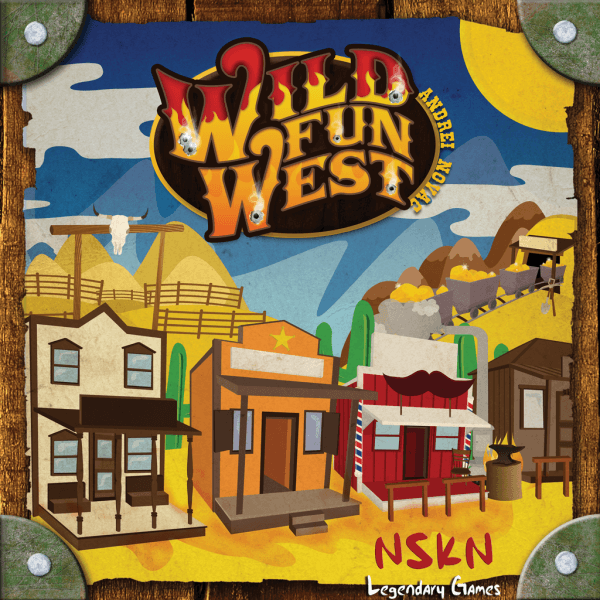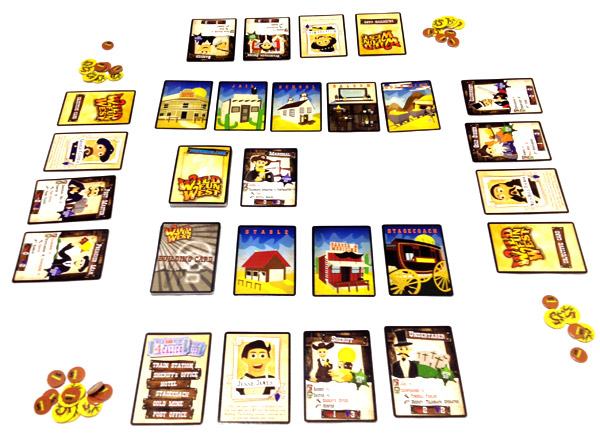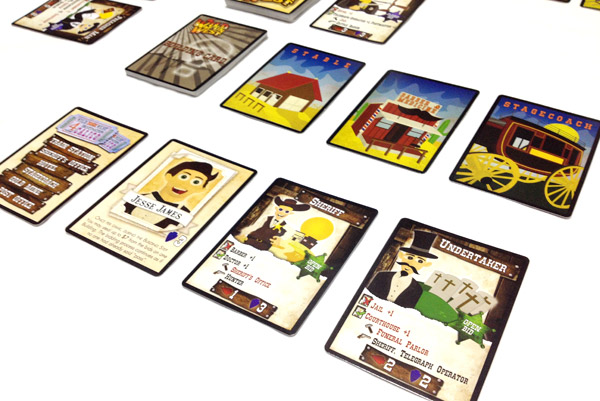Rootin'-Tootin' Bidding: A Review of Wild Fun West

Here in Arizona, we certainly know the wild west. And wild it is — but is there some fun to be had amid all of the rootin'-tootin' adventure? That was the question we set out to answer with Wild Fun West, a strategic auctioning game by NSKN Games for 4 to 8 players, ages 8 and up.
Gameplay
Wild Fun West is a card game that consists of 4 main types of cards — objective cards, character cards, profession cards, and building cards — as well as a bunch of money tokens. Players are working to build buildings in a western town to fulfill their own personal objectives. At the beginning of the game, each player is dealt a unique objective card, which is just a list of 6 different buildings. The object of the game is to be the first to have 4 of the 6 buildings built in the town area, which is collectively used by all players. Each player is also dealt a character card, which unconditionally earns a player 3 dollars at the end of each round and provides a special ability that can be used at certain points within the game.

The game is played in rounds that consist of 3 steps:
- Bidding for Professions — In this step, players bid on profession cards (Schoolmarm, Banker, Sheriff, etc.), which are the main catalyst for the game. A player can have up to 2 profession cards in play at any given time. A profession card contains information about the amount of money earned each round, bonuses or penalties if specific cards are or aren't in play, which buildings will give the owner a bidding advantage, and which other professions are banned from play. A certain number of cards are auctioned one at a time in either an open or closed auction, as specified on the card. Open auctions are done publicly, with the starting player placing a bid and other players raising the bid or passing as desired. A closed bid is done secretly, with each player placing a certain amount of money ($0 or above) in his closed fist and revealing it simultaneously. In either case, the highest bidder retrieves the card and adds it to his hand. To then put a profession card in play in front of himself, a player must pay $1 — but he cannot play the card if it is banned by another profession card. If a newly played card bans another profession, any player with that profession already in play must return it to his hand.
- Bidding for Buildings — In this step, players invest their money into the buildings they would most like to see built in the town (i.e., the ones on their objective cards). 3 building cards (School, Bank, Jail, etc.) are placed face up for everyone to see. Players then take turns placing money on the card of their choice or passing. If a building is listed on one of a player's profession cards that is currently in play, the money he places on that building is doubled by the bank. The building that receives the most money is built in the town. The others are discarded and the money spent on them is returned to the bank.
- Receiving Income — In this step, each player receives money according to the cards in play. A character card earns $3. Each profession card in play earns its owner a certain amount of money, as well as the player to the left. In addition, there are several modifiers on each card to either add or subtract from the owner's income, based on the other professions or buildings that are currently in play. For instance, the Gold Digger earns $2 extra if the gold mine has been built, and gains an additional $1 if there is no Banker in play.
Each round, the starting player (the player who makes the first bid) alternates clockwise. The game ends when 4 of a player's 6 buildings on his objective card have been built in the town. For a shorter game, this can be reduced to 3 of the 6 buildings.

Review
It is clear that this game has been well thought out. There are many interesting relationships between cards that make sense for the given professions and buildings, and it is amusing to discover these relationships and think about why they were included. In a small western town, there no doubt would have been some clashes between interests and personalities — why else would there be hootin' and hollerin' all the time? The Gambler would want nothing to do with the Illusionist, who could win a hand of poker by deception, and the Illusionist wouldn't want the Schoolmarm to educate his audience, or else he would be out of a job. There are plenty of ways that these professions can benefit each other, as well — the Dancehall Girl needs a Piano Player in order to dance, the Judge needs a Sheriff to bring him criminals, and the Trapper can get more animals using the Blacksmith's tools.
The relationships between different cards and players drive the interaction and strategy in the game. There are always many trade-offs to consider, including the fact that a profession card not only gives you money, but it might give some to your neighbor, as well. The ability to ban another card in play or alter the amount of money that can be earned by another profession can also prove to be a good balancing mechanism.
While all of these relationships are interesting, however, in practice they can make the game feel tedious. It's easy enough to read what is on your own cards, but players must constantly monitor all of the other cards on the table, looking not only for specific card titles, but also reading the fine print to discern these relationships. With the minimum group of 4 players, this is difficult enough, but with up to 8 players, it would turn into an all-out eye exam. This is not only true for deciding which cards to play, but also when adding up money at the end of each round.
Despite the tedium of monitoring all of the cards, there can also be some very fun moments, particularly when bidding for buildings. Players often share some of the same buildings on their objective cards, and this offers opportunities to work together to ensure that a particular building gets built. The bidding can get very tense, as we had one or two rounds where players teamed up against the others and nearly everyone went all-in for their building of choice (this can happen because the amount of money each player has is hidden from view). These bidding decisions are fueled by objective cards, which are by far the most plentiful included with the game — there are 12 sets of objective cards that appear to be carefully crafted for various numbers of players to ensure that these types of tense scenarios exist.
The artwork and graphic design for this game are endearing and quite appropriate for the theme. However, there are some quality issues: some of the cards have misspellings (e.g., "Chruch") and the cover art (particularly the back cover) appears pixelated and hard to read. Also, there is an expansion (event cards) included with the game, yet there is no mention of it included in the rulebook. I assume that a newer rulebook is available online, but the extra cards caused a bit of confusion at first.
In the end, this is a game that we really wanted to like, but it ended up being a bit too tedious and complex to feel like a good casual game. Our 4-player session lasted over 90 minutes, which was beyond the patience level of most of the players (the option to shorten the game to 3 buildings is recommended). The auctions can be fun, yet I'm not sure that two different styles for auctioning profession cards (open and closed) are worth the extra complexity. I believe there would be good potential for this game if the cards and auctions were simplified, the game were shortened, and the quality polished up a bit.
Pros: interesting card relationships, bidding can be fun and tense
Cons: hard to see and process all of the card information, relatively tedious and complex gameplay, some quality issues
Full disclosure: we received a complimentary review copy of this game.







